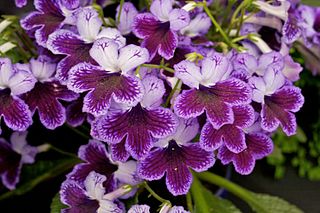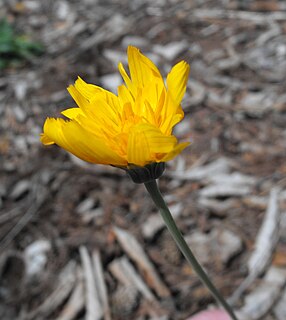
Callistephus is a monotypic genus of flowering plants in the aster family, Asteraceae, containing the single species Callistephus chinensis. Its common names include China aster and annual aster. It is native to China and Korea. and it is cultivated worldwide as an ornamental plant in cottage gardens and as a cut flower.

Alstroemeria, commonly called the Peruvian lily or lily of the Incas, is a genus of flowering plants in the family Alstroemeriaceae. They are all native to South America although some have become naturalized in the United States, Mexico, Australia, New Zealand, Madeira and the Canary Islands. Almost all of the species are restricted to one of two distinct centers of diversity, one in central Chile, the other in eastern Brazil. Species of Alstroemeria from Chile are winter-growing plants while those of Brazil are summer growing. All are long-lived perennials except A. graminea, a diminutive annual from the Atacama Desert of Chile.

Gerbera L. is a genus of plants in the Asteraceae (Compositae) family. The first scientific description of a Gerbera was made by J. D. Hooker in Curtis's Botanical Magazine in 1889 when he described Gerbera jamesonii, a South African species also known as Transvaal daisy or Barberton daisy. Gerbera is also commonly known as the African daisy.

Zantedeschia is a genus of eight species of herbaceous, perennial, flowering plants in the family Araceae, native to southern Africa from South Africa north to Malawi. The genus has been introduced on all continents except Antarctica. Common names include arum lily for Z. aethiopica and calla and calla lily for Z. elliottiana and Z. rehmannii, although members of the genus are neither true lilies of Liliaceae, true Arums, nor true Callas. The colourful flowers and leaves of both species and cultivars are greatly valued and commonly grown as ornamental plants.

A popular house plant, Streptocarpus, is an Afrotropical genus of flowering plants in the family Gesneriaceae. The genus is native to Afromontane biotopes from central, eastern and southern Africa, including Madagascar and the Comoro Islands. The flowers are five-petalled, salverform tubes, almost orchid-like in appearance, and hover or arch over the plant, while the pointed, elongate fruit is of a helical form similar to that of the "tusk" of a narwhal. In the wild, species can be found growing on shaded rocky hillsides or cliffs, on the ground, in rock crevices, and almost anywhere the seed can germinate and grow. For the home, there are now many hybrids of various colours and forms available.

Diplarrena is a genus of flowering plants in the family Iridaceae. The two species are endemic to Australia. The name is from Greek diploos ("double") and arren ("male"); plants in the genus have only two functional stamens, while all other Iridaceae have three. The name is often misspelled Diplarrhena, an error that began with George Bentham's Flora Australiensis in 1873.

Thunbergia alata, commonly called black-eyed Susan vine, is a herbaceous perennial climbing plant species in the family Acanthaceae. It is native to Eastern Africa, and has been naturalized in other parts of the world.

Triteleia crocea, with the common names yellow triteleia and yellow tripletlily, is a monocot flowering plant in the genus Triteleia.

Erysimum cheiri, syn. Cheiranthus cheiri, the wallflower, is a species of flowering plant in the family Brassicaceae (Cruciferae), native to Greece, but widespread as an introduced species elsewhere. It is also treated as a hybrid under the name Erysimum × cheiri. It is widely cultivated as a garden plant.
Mentzelia crocea, the Sierra blazingstar or saffron blazing star, is an annual wildflower endemic to the Sierra Nevada foothills of California.
Senecio transmarinus is a sometimes straggling member of the flowering plants Asteraceae and species of the genus Senecio a perennial herb that grows on the higher elevations of the Rwenzori Mountains in Uganda. It is also found in Rwanda and the Democratic Republic of the Congo. The inflorescences consist of several flowerheads with large yellow ray florets.

Ixia maculata is a species of flowering plant in the family Iridaceae known by the common name spotted African corn lily. It is native to the Cape Provinces of South Africa, but it is grown widely as an ornamental plant. It can also be found growing wild as an introduced species in several areas, including Western Australia. This perennial flower grows 20 to 70 centimeters tall with an erect, unbranched stem. There are a few twisting basal leaves up to 35 centimeters long. The inflorescence is a dense, showy spike of up to 12 flowers, usually orange to yellow in color, sometimes with areas of purple or red and often with spots; the coloration in garden plants varies due to breeding.

Malephora crocea is a species of flowering plant in the ice plant family known by the common name coppery mesemb and red ice plant. It is native to Africa and it is grown in many other places as an ornamental plant and a groundcover. In California and Baja California this is an introduced species and often a noxious weed in coastal habitat such as beaches and bluffs. It is planted along highways in California and in Arizona it is utilized in landscaping for its low water needs and tolerance of sun. It has been recommended as a groundcover in areas prone to wildfire in southern California due to its low flammability.

Krigia is a genus of North American flowering plants in the dandelion family. Plants of the genus are known generally as dwarf dandelions or dwarfdandelions.

Brachylaena discolor is a species of flowering plant in the aster family, Asteraceae. It is native to Africa, where it occurs in Mozambique, South Africa, and Eswatini. Its common names include coast silver oak and coastal silver oak.

Trianthema portulacastrum is a species of flowering plant in the ice plant family known by the common names desert horsepurslane, black pigweed, and giant pigweed. It is native to areas of several continents, including Africa and North and South America, and present as an introduced species in many other areas. It grows in a wide variety of habitat types and it can easily take hold in disturbed areas and cultivated land as a weed.

Penstemon attenuatus is a species of flowering plant in the plantain family known by the common names sulphur penstemon and taperleaf beardtongue. It is native to the northwestern United States.

Aeschynomene indica is a species of flowering plant in the legume family. Common names include Indian jointvetch, kat sola, budda pea, curly indigo, hard sola, northern jointvetch, indische Schampflanze (German), angiquinho, maricazinho, papquinha, pinheirinho, he meng (Chinese), kusanemu (Japanese), diya siyambala (Sinhala), and ikin sihk (Pohnpeian).

Iris series Spuriae are a series of the genus Iris, in Iris subg. Limniris. They are sometimes commonly known as butterfly irises.

Arctotis fastuosa, called Monarch-of-the-veld, is a species of African plants in the daisy family, native to Namibia and South Africa. It has become naturalized on roadsides and in vacant urban lots in southern California.


















